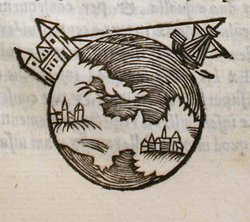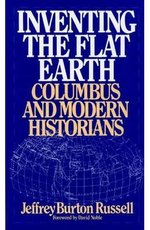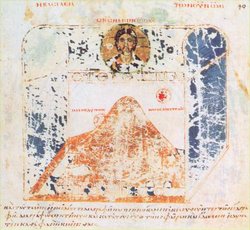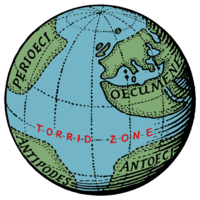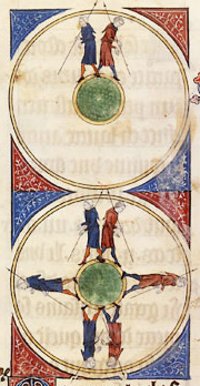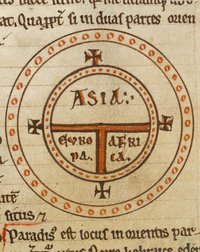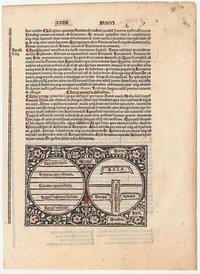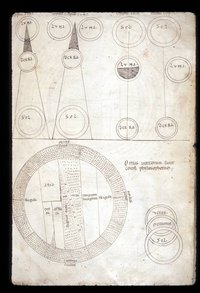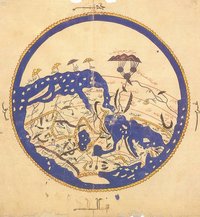
The modern myth of the medieval flat earth
Pablo de Felipe
Today, most people regard flat-earthism as the ultimate in nonsense and as scientific ‘heresy’. To be called a flat-earther is the ultimate of ‘scientific’ insults. For more than a century, however, this very insult has been hurled at a millennium of Western European history, regarded as the bastion of Christian flat-earthism. Christianity has been accused of the suppression of knowledge in this ‘dark age’. But is there any truth in this accusation?
Since the early 20th century a chorus of historians has denounced this supposed 1,000 years of ignorance (5th to 15th centuries), when scientific knowledge is said to have fallen to such a low ebb as to have nearly erased the wisdom of the ancient Greeks and to have flattened the globe.
These historians have also refuted the claim that belief in a flat earth reigned supreme until Columbus (or Magellan or Copernicus or some other 16th century figure) restored the truth of a round earth.
Armed with an erroneous vision of the past, however, internet warriors with sharp rhetoric make bold claims about the ‘hole left by Christian dark ages’ and the grand and steady progress made by science once unshackled from religion. Despite the clarity of 20th century scholarship on this matter, we should not minimize the potential of such rhetoric for providing ‘historical’ justification for a conflict view of science and faith relations, and for providing support to an agenda of removing religion from contemporary society.
Inventing the flat earth
Historians of science, particularly those specialising in the history of science and religion, have refuted the ‘conflict thesis’, demonstrating it to be an invention of the late 19th century, cooked up amidst the heated debates over Darwin and the increasing secularization of science. John W. Draper and Andrew D. White are often implicated in this artificial construction of warfare between science and faith, and a grand proof of this conflict is the supposed medieval belief in a flat earth.
During the 20th century a string of prominent scholars, going back to Francis S. Betten in 1923, and including names as illustrious as Lynn Thorndike, Samuel Eliot Morison, E.G.R. Taylor, C.S. Lewis and Edward Grant, rejected the claim that medieval culture was dominated by belief in a flat earth.
This denunciation culminated in a 1991 book, Inventing the Flat Earth (Fig. 2), by medievalist Jeffrey Burton Russell, who sought to discover the historical roots of this insidious accusation, which he called the ‘flat error’ (defined as the “almost universal supposition that educated medieval people believed the earth to be flat”, p. xiii). Russell identified as culprits for the flat error the early 19th century writer Washington Irving, whose fictionalised biography of Columbus was taken as historical, and the erudite academic historian Antoine-Jean Letronne, whose scholarly essay on the cosmographical views of the Church Fathers was taken as definitive.
True ancient flat-earthers
A careful search in the early Christian literature does indeed reveal some flat-earthers. However, two factors must be considered. First, although belief in the sphericity of the earth had been held by Plato and Aristotle in the 4th century BCE, during the Roman Empire many considered sphericity to be an invention of the philosophers. In spite of the triumphs of Alexandrian Hellenistic science, which calculated with great accuracy the size of the earth centuries before Christ, acclaimed writers such as the Epicurean philosopher Lucretius (c. 99-c.55 BCE) forcibly denied sphericity, while Pliny the Elder (c. 23-79 CE) and Plutarch (c. 45-120 CE), although not being flat-earthers themselves, outlined the arguments and objections to the spherical earth.
This points to the fact that even before the birth of Christ ancient science had entered a profound crisis. This was the era of the Encyclopaedists and Commentators. Roman authors became less interested in scientific research and innovation, and were content to compile information and offer summaries in Latin of past Greek scientific achievements. In addition, Neoplatonism and the moral philosophers were more interested in human and religious ideas, seeking the good life, human flourishing, and less interested in the natural and physical realm. This spiritual trend influenced the emergent Christianity.
Second, the number of Christian flat-earthers was quite small. Perhaps even more importantly, with the rare exception of Lactantius (c. 250-c. 325 CE), who followed the anti-philosophical rhetorical strategies of some sceptical intellectuals (and some Christian apologists), all known Christian flat-earthers can be identified with one particular theological school and hermeneutical method within ancient Christianity, the Antiochean school. Antioch was an important centre of early Christianity (a Patriarchate). Their distinctive theological school reacted against the allegorical excesses of the school of Alexandria, and defended a more literal, contextual and historical reading of the Bible. Sadly, their cosmology, influenced by this literal reading of the Bible produced belief in a box-shaped universe with a flat earth.
The victory of the sphere in the late antiquity church
The final confrontation between the Antiochian box-shaped and the Alexandrian spheric-shaped cosmologies took place in the 6th century. On one side we have the Christian Topography, the prolix work of a retired merchant, traditionally known as Cosmas Indicopleustes, but who was identified as Constantine of (not surprisingly) Antioch by some 20th century scholars. The bitter and rancorous attack on sphericity in this work probably points to the waning popularity of his flat earth cosmology (Fig. 3), and to the fact that the author was in enemy territory: Alexandria. While popular imagination believes that science had been erased after the assassination of the philosopher and mathematician Hypatia in 415 by a Christian mob, the truth is that science still flourished at Alexandria, and even Pagan teachers continued their activity. In fact, the ideas of Cosmas were confronted by no other than the top intellectual of the time in Alexandria: John Philoponus (c. 490-c. 570), who was, to make matters more complex, a fellow Christian. In his commentary on Genesis 1 (De Opificio Mundi) Philoponus fired back with sarcasm at the flat-earthers.
Echoes of the debate have been preserved in a book by the 7th century Armenian scientist Shirakatsi, who was critical of Cosmas. Two centuries later, the Patriarch of Constantinople Photius read Cosmas’ book and wrote a devastating review of it in his Bibliotheca. By then the Antiochian theologians had been condemned on theological grounds as part of the Nestorian heresy, which contributed to the demise of their cosmology.
The only known Western Latin author to attack belief in the spheric earth, Lactantius, was read by Augustine of Hippo. Augustine sought to surpass Lactantius’ apologetic book Divine Institutes with his still famous City of God. Augustine maintained a critical view on the possibility of humans living on the other side of the earth (the antipodeans), but removed any criticism of the sphericity of the earth. Lactantius was rarely read afterwards. Augustine’s sustained criticism of antipodeans gave rise to a vigorous medieval debate over the existence of humans south the equator (conceived by the Ancient Roman geographers as a fiery uncrossable ring) or in other landmasses separated by huge oceans (Fig. 4). For Augustine and medieval theologians such barriers suggested that any antipodeans could not be descendants of Adam and their existence would become a puzzling problem.
The medieval earth ball
As the Western Roman world became dismembered in its political unity and organization, the Latin West became disconnected from the Greek Eastern Roman Empire for a millennium. While the ancient philosophers and scientists continued to be copied and read in the East, and passed on to the new Muslim empire, the West languished academically, as very few texts had been translated into Latin, few people knew Greek, and communications in the Mediterranean were lost. Some have doubted that the sphericity of the earth was still known at the time, but this seems to be an over-reaction. In any case, the medieval Catholic Church never made a declaration regarding the shape of the earth, and already with the monk Bede (673-735) in the North of England we find a robust defense of the sphericity of the earth.
Conscious of what had been lost, and inheritors of the ‘conservative’ tradition of the late antique commentators, medieval intellectuals sought to reconstruct the missing knowledge. Such an approach was based not on a disregard of the past, but rather on an excessive adoration of the ancient luminaries of knowledge, such as Plato and Aristotle.
The Carolingian ‘renaissance’ in the 8th century, the founding of universities from the 11th century onwards, the frenetic activity of translators during the 11th to 12th centuries, the ‘renaissance’ of the 12th century that followed, and the profound debates and sometimes strong critical reactions towards ancient learning of scholastics from the 12th to the 14th centuries, all reflect a clear knowledge of the sphericity of the earth and the ancient astronomy/geography that were readily followed by the European scholars and religious authors (Fig. 1 and 5).
Even very popular books, such as Dante’s Divine Comedy (early 14th century) and the fictional Jean de Mandeville’s Travels (late 14th century), one of the most widely read medieval books for the next two centuries, clearly upheld the sphericity of the earth.
The real debates and fears before Columbus
It was a failure to understand the medieval age and a debate over antipodeans that was not connected in any way with a belief in a flat earth, that led historians and scholars to misread the evidence and conclude that medieval persons lived in darkness and ignorance. A telling illustration of this failure concerns the famous ‘T-O maps’ (Fig. 6, usually the top is the East). Their circularity was not intended to represent a disk-shaped earth. They intended to identify only the portions of the earth relevant to the reader, the three known continents in the Northern hemisphere, within a circular oceanic frame (following models that seem to go back to the Ancient Roman period).
In fact, it is not difficult to find them in the same books where other ‘zonal maps’ appear (also of Roman origin) giving a view of the whole planet with the frozen poles at the top and the bottom, the fiery equator in the centre, and two temperate zones in between (in some cases both maps appear side-by-side, Fig. 7). There are also examples of both maps fused in a zonal map that contains the T-O map confined in the temperate zone of the Northern hemisphere within a rectangular frame (Fig. 8). Islamic cartography also depicted the inhabited world with a circular oceanic frame that in some cases included lines delineating climatic zones (Fig. 9, the top is the South).
Sphericity was the premise of Columbus’ enterprise (that he learned in medieval books written by ecclesiastical authors like Pierre d’Ailly). In the debates at the Spanish court leading to his famous first Atlantic crossing, he was not opposed by fanatic, flat-earther clerics. They were instead concerned by the distance, the difficulty of return, and speculations regarding the antipodeans, etc. Ironically, in debating with Columbus, they used the sphericity of the earth against his sailing plans!
The rise of the myth of the Christian flat earth
The identification by J. B. Russell of Irving and Letronne as the sole culprits inventing the flat error has been followed by many in the last 25 years. However, other historians have described a more complex view of how the flat error was constructed.
Rudolf Simek and Reinhard Krüger have pointed to the importance of the rediscovery of Cosmas in 1706 and, even more, to Montfaucon’s preface in its republication, in which Montfaucon erred in a broad generalization, accusing the early Christian writers and Church Fathers of following the flat earth views of Cosmas. Additional evidence points to the existence of an even more complex prehistory of the flat error before the 19th century and also a prehistory of the conflict model for science and faith relationships. Indeed, I am currently studying in detail the relevant ideological transformations from the late medieval period up to the 18th century.
The invention of the ‘dark ages’ by Renaissance scholars is a complex story. Humanists wanted to renew the study of classical authors and the original texts without the mediation of medieval scholars, as medieval transmission was deemed faulty in several aspects. Paradoxically, the Renaissance, which is often seen as a very progressive period, not only hid many previous achievements, but was also less progressive than is often imagined, as it was actually the culmination of the old project of the Roman and medieval commentators. It was a Re-naissance, still a backward-looking movement, which exalted Aristotle and other ancient sages. To make things more complex and paradoxical, the Reformation of the early 16th century and the confrontation and polarization that ensued, gave European intellectuals much less freedom to disagree with religious authorities and traditional views than in the scholastic era. In spite of this, many Protestants reinforced a prejudice towards the Middle Ages that they saw as a period of Catholic oppression. Enlightenment scholars did not have a better opinion and maligned the entire Christian past (of whatever confession) up to their own time.
Somewhere during this period, and in particular after the rediscovery of Cosmas and the increasing criticism of the Christian tradition, the supposedly flat earth belief of medieval Christians became the ideal topic to concentrate all the bitterness of the moderns against the past. The myth that was engendered then still lives on, taught to our children at school and endlessly repeated by mass media, films, novels, etc. It is a central piece in the contemporary larger myth of the science and faith conflict. A myth that would not die, astonishingly, in spite of the fact that in the 15th century nobody was afraid of falling off the edge of the earth.
Pablo de Felipe
Published January 2017
Edited on 16-7-2017
We offer this article also in a German translation.
Acknowledgements: This publication was made possible through the support of a donation from Templeton World Charity Foundation, Inc. (www.templetonworldcharity.org). The opinions expressed in this publication are those of the author and do not necessarily reflect the views of the foundation.
Pablo de Felipe is currently a PhD student at the Department of Classics of the University of Reading (UK) researching the historical origins of the flat error here described. The Faraday Institute for Science and Religion (faraday-institute.org, UK) supports Pablo de Felipe in his PhD studies.
I thank Dr. Robert D. Keay for a helpful revision of the text.
Pablo de Felipe obtained a PhD in Chemistry (Molecular Biology) at the Universidad Autónoma de Madrid (Spain). He worked as a Research Fellow at the University of St Andrews (UK) before joining the Spanish Medicines Agency. Since April 2016 he is a lecturer in science and faith at the SEUT School of Theology, an Evangelical institution in Madrid, Spain (www.facultadseut.org) where he also coordinates the Centro de Ciencia y Fe (Centre for Science & Faith, www.cienciayfe.es), belonging to the Fundación Federico Fliedner (www.fliedner.es, Spain).
Further Reading
The flat error has been recently denounced in two brief chapters of compendia of similar popular myths: Louise M. Bishop, ‘The Myth of the Flat Earth’. In: Stephen J. Harris and Bryon L. Grigsby (eds.). Misconceptions About the Middle Ages (New York and London: Routledge, 2008), 97-101. Lesley B. Cormack, ‘Myth 3: That Medieval Christians Taught that the Earth was Flat’. In: Ronald L. Numbers (ed.). Galileo Goes to Jail and Other Myths About Science and Religion (Cambridge, MA and London: Harvard University Press, 2009), 28-34.
For a discussion of the ancient and medieval debates on the flat earth and the antipodes, see Pablo de Felipe and Robert D. Keay, ’Science and Faith Issues in Ancient and Medieval Christianity’, parts 1, 2 and 3. BioLogos Blog, December 2nd, 3rd and 4th, 2013, available at: biologos.org/blogs/archive/series/science-and-faith-issues-in-ancient-and-medieval-christianity.
For an introduction to medieval maps, see Evelyn Edson, Mapping Time and Space: how medieval mapmakers viewed their world (London: British Library, 1997).
For the myth of a science and faith conflict, see here Peter Harrison, ‘The Myth of a Perennial Battle between Science and Religion’. Dialog Theologie & Naturwissenschaften web site, 2016, available at: www.theologie-naturwissenschaften.de/startseite/leitartikelarchiv/conflict-myth.html.
Picture credits
Fig. 1 Image from Sacrobosco’s On the Sphere of the World (13th century, print edition of 1550) illustrating the sphericity of the earth (c) Wikimedia commons
Fig. 2 Cover of Jeffrey Burton Russell, Inventing the Flat Earth (1991)
Fig. 3 Cosmas Indicopleustes cosmology from Christian Topography (c. 550, copy from the 11th century) (c) Wikimedia commons
Fig. 4 The four landmasses as imagined in the Hellenistic cosmology (c) Wikimedia commons
Fig. 5 Image from Gossuin de Metz’s L’Image du Monde (13th century, copy from the 14th century) illustrating the sphericity of the earth (c) Wikimedia commons
Fig. 6 Typical example of a T-O map from Isidore’s Etymologies (7th century, copy of the 12th century) (c) Wikimedia commons
Fig. 7 Example of a T-O map side-by-side with a zonal map from Giacomo Foresti’s Novissime hystoriarum omnium repercussiones (1483; first illustrated edition, 1486; this image is from the edition of 1503, the image does not seem to appear in earlier editions, at least until 1492) (c) Wikimedia commons
Fig. 8 Image of a zonal map containing a T-O map in the Northern temperate zone from the Arnstein Bible (12th century) (c) British Library
Fig. 9 World map in a copy of Al-Idrisi's treatise (1154, copy dated 1553) (c) Wikimedia commons

